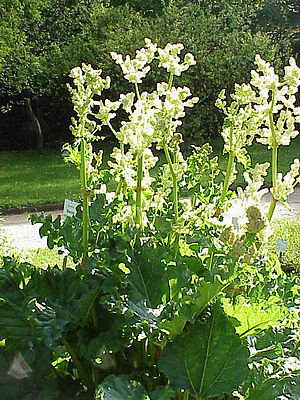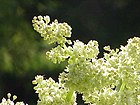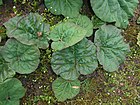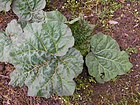Note: This is a project under development. The articles on this wiki are just being initiated and broadly incomplete. You can Help creating new pages.
Difference between revisions of "Rheum officinale"
| Line 1: | Line 1: | ||
[[File:Rheum officinale1.jpg|thumb|right]] | [[File:Rheum officinale1.jpg|thumb|right]] | ||
| + | '''Rheum officinale''' is a perennial plant that can grow up to 2.00 metres tall. It is harvested from the wild for local use as a food, medicine and source of materials. | ||
==Uses== | ==Uses== | ||
| − | {{Uses|}}, {{Uses|}}, {{Uses|}}, {{Uses|}}, {{Uses|}}, {{Uses|}}, {{Uses| | + | {{Uses|Chronic constipation}}, {{Uses|Diarrhoea}}, {{Uses|Gall bladder complaints}}, {{Uses|Haemorrhoids}}, {{Uses|Menstrual problems}}, {{Uses|Skin eruptions}}, {{Uses|Burns}}.<ref name="Uses"/> |
==Parts Used== | ==Parts Used== | ||
| − | {{Parts Used| | + | {{Parts Used|Leaf stem}}. |
==Chemical Composition== | ==Chemical Composition== | ||
| − | <ref name="chemical composition"/> | + | It contains 10S-3-methyl-1,8,10-trihydroxy-10-β-D-glucopyranosyl-9(10H)-anthracenone and eight known compounds were isolated from the roots of Rheum officinale for the first time. Their structures were elucidated by analysis of spectroscopic methods.<ref name="chemical composition"/> |
==Common names== | ==Common names== | ||
| Line 28: | Line 29: | ||
==Habit== | ==Habit== | ||
| − | {{Habit|}} | + | {{Habit|Perennial}} |
==Identification== | ==Identification== | ||
| Line 47: | Line 48: | ||
==Mode of Propagation== | ==Mode of Propagation== | ||
| − | {{Propagation|}} | + | {{Propagation|Seeds}} |
==How to plant/cultivate== | ==How to plant/cultivate== | ||
| − | <ref name="How to plant/cultivate"/> | + | Prefers a deep, fertile, moderately heavy, humus rich, moisture retentive, well-drained soil in sun or semi-shade.<ref name="How to plant/cultivate"/> |
==Commonly seen growing in areas== | ==Commonly seen growing in areas== | ||
| − | {{Commonly seen| | + | {{Commonly seen|Hillsides}}. |
==Photo Gallery== | ==Photo Gallery== | ||
| Line 67: | Line 68: | ||
<references> | <references> | ||
| − | <ref name="chemical composition">[Chemistry]</ref> | + | <ref name="chemical composition">[https://www.researchgate.net/publication/271738371_Chemical_constituents_of_the_roots_of_Rheum_officinale Chemistry]</ref> |
<ref name="Leaf">[Morphology]</ref> | <ref name="Leaf">[Morphology]</ref> | ||
| − | <ref name="How to plant/cultivate">[Cultivation]</ref> | + | <ref name="How to plant/cultivate">[http://temperate.theferns.info/plant/Rheum+officinale Cultivation]</ref> |
<ref name="Uses">Indian Medicinal Plants by C.P.Khare</ref> | <ref name="Uses">Indian Medicinal Plants by C.P.Khare</ref> | ||
</references> | </references> | ||
==External Links== | ==External Links== | ||
| − | * [ ] | + | * [https://www.sciencedirect.com/topics/agricultural-and-biological-sciences/rheum-officinale Rheum officinale on sciencedirect.com] |
| − | * [ ] | + | * [https://pfaf.org/user/Plant.aspx?LatinName=Rheum+officinale Rheum officinale on pfaf.org] |
| − | + | ||
[[Category:Herbs]] | [[Category:Herbs]] | ||
Latest revision as of 11:43, 15 June 2020
Rheum officinale is a perennial plant that can grow up to 2.00 metres tall. It is harvested from the wild for local use as a food, medicine and source of materials.
Contents
- 1 Uses
- 2 Parts Used
- 3 Chemical Composition
- 4 Common names
- 5 Properties
- 6 Habit
- 7 Identification
- 8 List of Ayurvedic medicine in which the herb is used
- 9 Where to get the saplings
- 10 Mode of Propagation
- 11 How to plant/cultivate
- 12 Commonly seen growing in areas
- 13 Photo Gallery
- 14 References
- 15 External Links
Uses
Chronic constipation, Diarrhoea, Gall bladder complaints, Haemorrhoids, Menstrual problems, Skin eruptions, Burns.[1]
Parts Used
Chemical Composition
It contains 10S-3-methyl-1,8,10-trihydroxy-10-β-D-glucopyranosyl-9(10H)-anthracenone and eight known compounds were isolated from the roots of Rheum officinale for the first time. Their structures were elucidated by analysis of spectroscopic methods.[2]
Common names
| Language | Common name |
|---|---|
| Kannada | |
| Hindi | |
| Malayalam | |
| Tamil | |
| Telugu | |
| Marathi | |
| Gujarathi | |
| Punjabi | |
| Kashmiri | |
| Sanskrit | |
| English |
Properties
Reference: Dravya - Substance, Rasa - Taste, Guna - Qualities, Veerya - Potency, Vipaka - Post-digesion effect, Karma - Pharmacological activity, Prabhava - Therepeutics.
Dravya
Rasa
Guna
Veerya
Vipaka
Karma
Prabhava
Habit
Identification
Leaf
| Kind | Shape | Feature |
|---|---|---|
Flower
| Type | Size | Color and composition | Stamen | More information |
|---|---|---|---|---|
| {{{5}}} |
Fruit
| Type | Size | Mass | Appearance | Seeds | More information |
|---|---|---|---|---|---|
Other features
List of Ayurvedic medicine in which the herb is used
Where to get the saplings
Mode of Propagation
How to plant/cultivate
Prefers a deep, fertile, moderately heavy, humus rich, moisture retentive, well-drained soil in sun or semi-shade.[4]
Commonly seen growing in areas
Photo Gallery
References
External Links
- Ayurvedic Herbs known to be helpful to treat Chronic constipation
- Ayurvedic Herbs known to be helpful to treat Diarrhoea
- Ayurvedic Herbs known to be helpful to treat Gall bladder complaints
- Ayurvedic Herbs known to be helpful to treat Haemorrhoids
- Ayurvedic Herbs known to be helpful to treat Menstrual problems
- Ayurvedic Herbs known to be helpful to treat Skin eruptions
- Ayurvedic Herbs known to be helpful to treat Burns
- Herbs with Leaf stem used in medicine
- Habit - Perennial
- Index of Plants which can be propagated by Seeds
- Herbs that are commonly seen in the region of Hillsides
- Herbs





